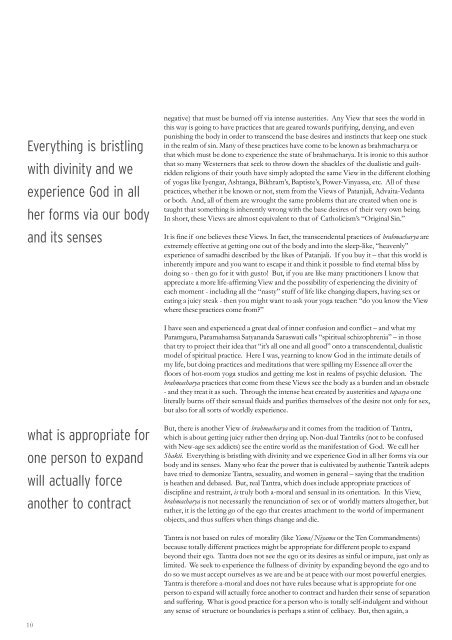Create successful ePaper yourself
Turn your PDF publications into a flip-book with our unique Google optimized e-Paper software.
Everything is bristling<br />
with divinity and we<br />
experience God in all<br />
her forms via our body<br />
and its senses<br />
negative) that must be burned off via intense austerities. Any View that sees the world in<br />
this way is going to have practices that are geared towards purifying, denying, and even<br />
punishing the body in order to transcend the base desires and instincts that keep one stuck<br />
in the realm of sin. Many of these practices have come to be known as brahmacharya or<br />
that which must be done to experience the state of brahmacharya. It is ironic to this author<br />
that so many Westerners that seek to throw down the shackles of the dualistic and guiltridden<br />
religions of their youth have simply adopted the same View in the different clothing<br />
of yogas like Iyengar, Ashtanga, Bikhram’s, Baptiste’s, Power-Vinyassa, etc. All of these<br />
practices, whether it be known or not, stem from the Views of Patanjali, Advaita-Vedanta<br />
or both. And, all of them are wrought the same problems that are created when one is<br />
taught that something is inherently wrong with the base desires of their very own being.<br />
In short, these Views are almost equivalent to that of Catholicism’s “Original Sin.”<br />
It is fine if one believes these Views. In fact, the transcendental practices of brahmacharya are<br />
extremely effective at getting one out of the body and into the sleep-like, “heavenly”<br />
experience of samadhi described by the likes of Patanjali. If you buy it – that this world is<br />
inherently impure and you want to escape it and think it possible to find eternal bliss by<br />
doing so - then go for it with gusto! But, if you are like many practitioners I know that<br />
appreciate a more life-affirming View and the possibility of experiencing the divinity of<br />
each moment - including all the “nasty” stuff of life like changing diapers, having sex or<br />
eating a juicy steak - then you might want to ask your yoga teacher: “do you know the View<br />
where these practices come from?”<br />
I have seen and experienced a great deal of inner confusion and conflict – and what my<br />
Paramguru, Paramahamsa Satyananda Saraswati calls “spiritual schizophrenia” – in those<br />
that try to project their idea that “it’s all one and all good” onto a transcendental, dualistic<br />
model of spiritual practice. Here I was, yearning to know God in the intimate details of<br />
my life, but doing practices and meditations that were spilling my Essence all over the<br />
floors of hot-room yoga studios and getting me lost in realms of psychic delusion. The<br />
brahmacharya practices that come from these Views see the body as a burden and an obstacle<br />
- and they treat it as such. Through the intense heat created by austerities and tapasya one<br />
literally burns off their sensual fluids and purifies themselves of the desire not only for sex,<br />
but also for all sorts of worldly experience.<br />
what is appropriate for<br />
one person to expand<br />
will actually force<br />
another to contract<br />
But, there is another View of brahmacharya and it comes from the tradition of Tantra,<br />
which is about getting juicy rather then drying up. Non-dual Tantriks (not to be confused<br />
with New-age sex addicts) see the entire world as the manifestation of God. We call her<br />
Shakti. Everything is bristling with divinity and we experience God in all her forms via our<br />
body and its senses. Many who fear the power that is cultivated by authentic Tantrik adepts<br />
have tried to demonize Tantra, sexuality, and women in general – saying that the tradition<br />
is heathen and debased. But, real Tantra, which does include appropriate practices of<br />
discipline and restraint, is truly both a-moral and sensual in its orientation. In this View,<br />
brahmacharya is not necessarily the renunciation of sex or of worldly matters altogether, but<br />
rather, it is the letting go of the ego that creates attachment to the world of impermanent<br />
objects, and thus suffers when things change and die.<br />
Tantra is not based on rules of morality (like Yama/Niyama or the Ten Commandments)<br />
because totally different practices might be appropriate for different people to expand<br />
beyond their ego. Tantra does not see the ego or its desires as sinful or impure, just only as<br />
limited. We seek to experience the fullness of divinity by expanding beyond the ego and to<br />
do so we must accept ourselves as we are and be at peace with our most powerful energies.<br />
Tantra is therefore a-moral and does not have rules because what is appropriate for one<br />
person to expand will actually force another to contract and harden their sense of separation<br />
and suffering. What is good practice for a person who is totally self-indulgent and without<br />
any sense of structure or boundaries is perhaps a stint of celibacy. But, then again, a<br />
10

















